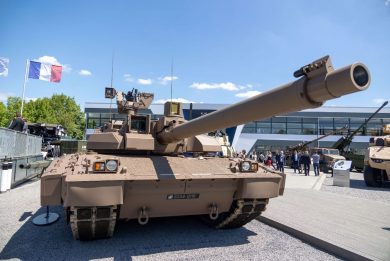Eurosatory 2024 – KNDS ASCALON gun system becomes a family
At Eurosatory 2024 KNDS unveiled the 120 mm version of its ASCALON gun, which joins the 140 mm already seen in the past editions, the ASCALON becoming therefore a family of guns
Of course, the KNDS stand was dominated by the three new MBTs exhibited in Paris, the Leclerc Evolution, the Leopard 2 ARC 3.0, and the ADT 140, the acronym standing for ASCALON Demonstration Turret. All three have a have a common denominator, the Autoloaded and SCALable Outperforming guN, ASCALON in short.
EDR On-Line dealt with this topic in the past, the 2024 edition of Eurosatory being the right place to check the programme status and the progress that were made in the recent past.
The first obvious step forward was that from a single gun, in the 140 mm calibre, the ASCALON evolved into a family of guns, the 120 mm one being added. What was underlined by the company is that to switch from one calibre to the other it is “sufficient” to unscrew the barrel and replace it with that of the other calibre.
EDR On-Line was told that this is an evolutionary gun compared to current 120 mm, as it is designed to be compatible with existing ammunition in that calibre. The main driver in the development of the ASCALON 120, as it is known, was the capacity to provide the customer with a gun that could, in the future, be easily transformed in a 140 mm weapon. In fact, the breech is designed and dimensioned to cope with pressures and strains generated by 140 mm APFSDS rounds, kinetic energy (KE) ammunition being the most critical in the design as they are those developing the higher energy. The current muzzle energy for the KE round under development is around 18 MJ, which is considered sufficient to defeat current threats, however an over 10% growth potential is available, KNDS considering a 20 MJ muzzle energy for future rounds.
The ASCALON 120 has a 58-calibre barrel; the extra length compared to the 120/55 does not add much in terms of energy, as the muzzle velocity is around 10 m/s higher, less than 0.6%. According to company sources the gun is lighter than the 120/55 and is better balanced, which should have positive effects on stabilisation and accuracy. The weapon is 7,230 mm long and the oscillating mass is 3,050 kg. In late February this year KNDS announced the qualification of its SHARD 120 APFSDS ammunition, which perfectly complements the ASCALON 120; this ensures a 15% increase in penetration against rolled homogeneous armour with a low level of dispersion, reduces barrel by 25%, and has a V0 of 1,734 m/s when fired from a 120/55 mm gun. The penetrator was developed in cooperation with Plansee High Performance Materials, the world-leading manufacturer of tungsten components which main HQ is in Reutte, Austria. The first firing of the ASCALON 120 took place in May this year from a fixed stand.
Coming to the ASCALON 140, its oscillating mass is around 3,300 kg, and when fitted with armour plates it is also well balanced according to KNDS. As the breech is the same, the barrel being shorter, 6,720 mm versus the 6,960 mm of the 120 mm barrel, the overall length of the ASCALON 140 should be 6,990 mm. The bigger calibre and the higher muzzle energy give the 140 mm APFSDS round a much higher energy on target compared to 120 mm ones. KNDS declares an increase between 40% and 70%. This difference is due to the fact that two different KE rounds are currently under development at Bourges.
The more advanced one has a penetrator of around 1 metre length and is dubbed “short rod” although, according to company sources, it is the longest rod ever produced. The penetrator has been validated, while EDR On-Line understood that work is being done to further optimising some elements to increase V0, a key factor considering that, in the KE formula, speed is squared. Work is being done on the sabot, to further reduce its mass hence increasing the V0, as well as on energetics, this time in cooperation with Eurenco, which is fully linked to KNDS France. The 140 mm APFSDS ammunition was visible, with the sabot adopted by KNDS for the 120 mm SHARD APFSDS round; in fact, the design of the sabot adopted on the SHARD was developed for the 140 mm round, then first adopted on the 120 mm and now it is back also on the 140 mm.
The round is semi-telescoped, which allows reducing its length, a key issue in ensuring compatibility with the autoloader without the need to extend the turret bustle. As the ammunition diameter is practically the same between 120- and 140-mm rounds, the autoloader is also the same, the rammer being set according to the round length. The so-called “long rod” is currently undergoing validation, and this will bring performances at a +70% compared to 120 mm APFSDS. EDR On-Line understood that the short-rod should be qualified within the year, no data being provided for the long-rod; no confirmation was given, but it is highly probable that also for these rounds KNDS is working in cooperation with Plansee.
To cope with the recoil the ASCALON 140 is fitted with the “pepperbox” muzzle brake already seen in the past, with a series of seven vents in line along the circumference. The prototype barrel exhibited in Paris was fitted with a thread; this was to be used to install a further recoil brake, probably of the baffle type, but according to information obtained the pepper-box performances have shown that the second element is not required, therefor future barrels will not feature the thread.
The KNDS R&D centre in Bourges is also working on technologies that will lead to the development of 140 mm guided ammunition, which will allow hitting targets at ranges much higher than those attainable with unguided rounds, although they should not be of the KE type. As for the ASCALON 140 gun, first firings of the weapon installed in the ADT 140 development turret are expected in 2025.
Looking towards the future Main Ground Combat System, better known as MGCS.
Photo by P. Valpolini









